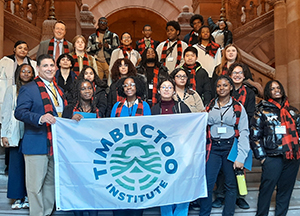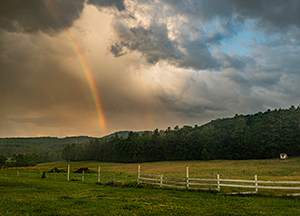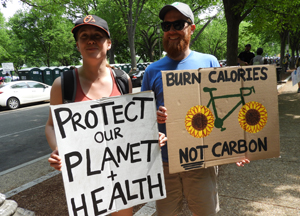
Boreas Acquisition Latest Step Towards Wilderness Protection

Wednesday, June 1, 2016
By: Diane Fish - Adirondack Council Deputy Director
Governor Andrew Cuomo traveled to the Adirondacks on May 10 to celebrate the state’s recent acquisition from the Adirondack Nature Conservancy of the Boreas Ponds tract. Boreas Ponds, a 20,500 acre parcel of forests and waters, is the state's final purchase and the “crown jewel” of the former Finch Pruyn paper company lands. Since 2012, the state has purchased 69,000 of former Finch lands for addition to the Forest Preserve and acquired a conservation easement on the remaining 92,000 acres of timberland, ensuring that it will be sustainably harvested and protected from development.
“We’re completing the largest acquisition to the Park in 100 years…The soul of the State of New York is singing,” said the Governor.
The Adirondack Council has been preparing for this announcement knowing that it would present a once-in-a-lifetime opportunity to expand the High Peaks Wilderness Area and create 280,000 acres of contiguous Wilderness in the heart of the Adirondacks.
In a letter to the Governor last November, the Council joined with other conservation organizations calling on the Governor to protect  the Boreas Ponds - and several other state-owned parcels nearby - with a Wilderness classification. Soon after, the Council launched the BeWildNY campaign. The campaign and the support for wilderness quickly earned praise from the regional news media. In a March editorial, the Watertown Daily Times said, “The state should proceed with buying the Boreas Ponds land, designate it as a Wilderness area and expand the High Peaks Wilderness. Future generations will appreciate the forward thinking that has gone into this effort to enhance the Adirondack Park.”
the Boreas Ponds - and several other state-owned parcels nearby - with a Wilderness classification. Soon after, the Council launched the BeWildNY campaign. The campaign and the support for wilderness quickly earned praise from the regional news media. In a March editorial, the Watertown Daily Times said, “The state should proceed with buying the Boreas Ponds land, designate it as a Wilderness area and expand the High Peaks Wilderness. Future generations will appreciate the forward thinking that has gone into this effort to enhance the Adirondack Park.”
Three studies commissioned by the Council were recently released by the BeWildNY coalition. Two scientific studies provide support for classifying the Boreas Ponds tract as Wilderness where only non-motorized and non-mechanized recreation is permitted. In his summary, “My evaluation showed that the tract exhibits high levels of ecological integrity and wild character, while its wetlands, steep slopes and erodible soils make it a poor choice for siting roads,” said Dr. Ezra Schwartzberg of Adirondack Research, LLC in the executive summary of his report. Click HERE to read study.
The Wildlife Conservation Society Adirondack Program also completed a research study. “Boreas has larger patches of Northern Hardwood and Conifer, Northern Peatland, and Northern Swamp, patches of which are larger, on average, on the Boreas tract than those on existing state land units,” the study notes. “If added to the High Peaks (Wilderness) management unit, the Boreas tract would enhance overall resilience, integrity, and local and regional connectedness of that unit … all of which are above average on the Boreas tract.” Click HERE to read study.
It is important to the Council that the host communities benefit from a future Wilderness classification. Recent studies show it is likely that they will.
A study by Clarkson University shows that property close to Wilderness areas has sold for up to 25-percent more than similar property elsewhere in the 12 counties that make up the Adirondack Park. “Overall, our results suggest that Wilderness land has significant positive impacts on nearby property values … This result is reasonable since allowing motorized vehicle use in (other lands) may destroy wildlife habitat, degrade the region’s bio-integrity … and produce undesirable effects like noise and pollution,” the study said. The study shows the positive economic impact of Wilderness. The Council hopes this data encourages further state investment in tourism infrastructure in the five host towns (Minerva, Long Lake, Newcomb, North Hudson, and Indian Lake) that are gateways to the Boreas Ponds and other former Nature Conservancy/Finch lands.
With the purchase of the Boreas Ponds tract complete, the BeWildNY coalition continues to expand, and conservation organizations both individually and collectively are ramping up efforts to educate the public about the incredible opportunity to creating a lasting legacy in the High Peaks. Thousands of people have signed petitions and written letters to the Governor. Next up? A call for statewide public hearings, where a strong turnout will make a difference, and a public comment period when YOUR participation will help make Wilderness.
Would you like to comment on what you've read or viewed? We'd love to hear from you. Please click to send us a message.
 Diane W. Fish is the Adirondack Council's Deputy Director.
Diane W. Fish is the Adirondack Council's Deputy Director.
Diane joined the Council staff in 2001 and works with the Board and Staff to raise the financial resources needed to support the Council's conservation and advocacy efforts on behalf of the Park. An important step in this process is keeping in touch with supporters in all 50 states to understand their interests and concerns about the Adirondack Park and to engage members in the Council’s advocacy efforts.
Diane holds a BA from Denison University and a Masters Degree from Skidmore College. She and her husband live in Lake Placid. Diane shares other Council supporters' love of the Adirondacks, enjoys the Park's many outdoor recreation activities, and appreciates the astounding beauty of the Park every day.




